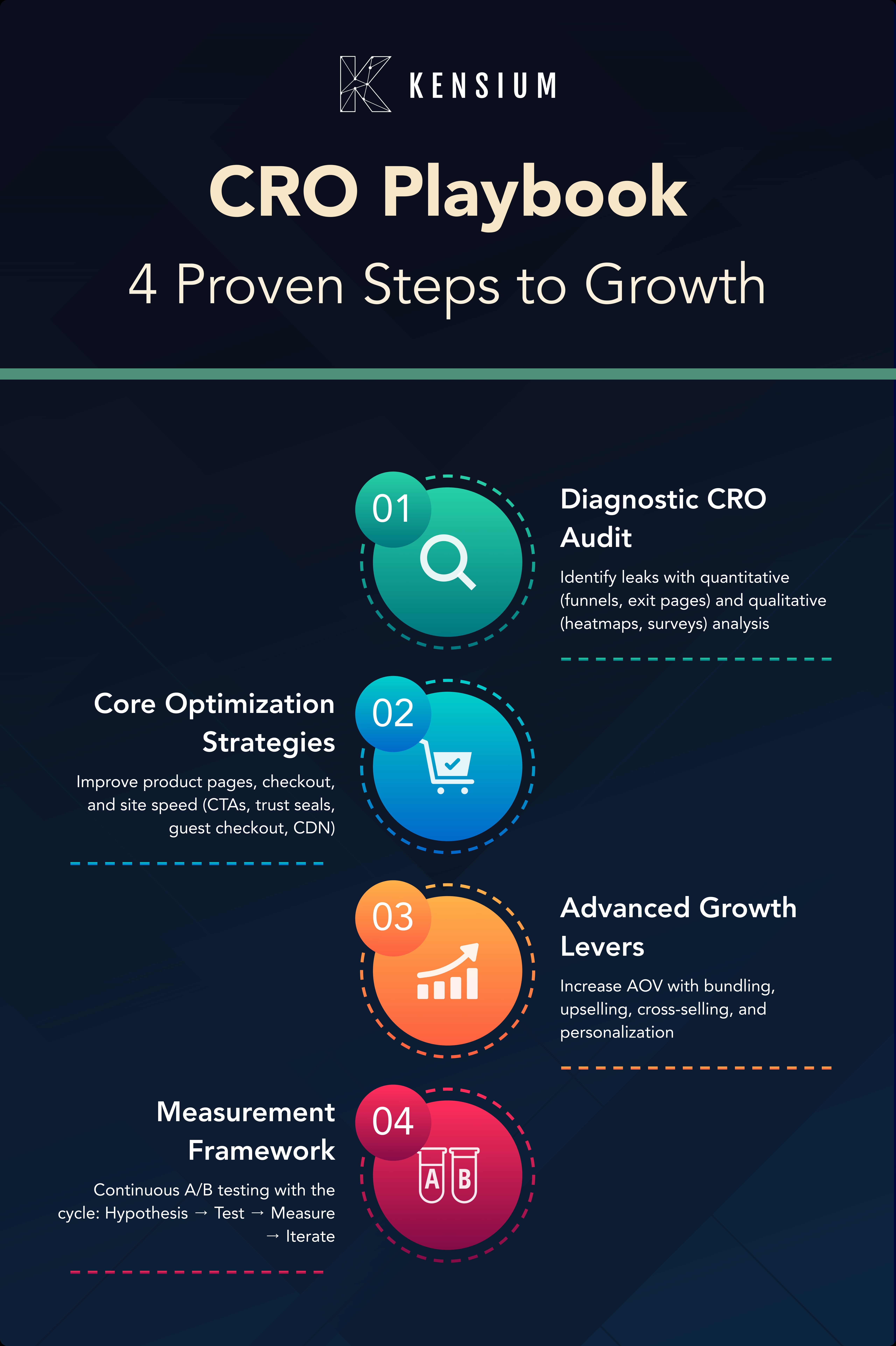
Running an eCommerce business is more than managing a storefront — it’s orchestrating a symphony of moving parts. You’ve got customer service tickets coming in, inventory syncing (or not) across systems, orders that need fulfillment, and financials waiting to be reconciled. One tool handles your marketing, another your product data, and yet another your accounting — and none of them talk to each other. Sound familiar?
For growing eCommerce businesses — especially in the B2B space — siloed systems and disconnected tools aren’t just annoying. They’re costly. They lead to manual work, inaccurate data, delayed decisions, and lost sales. That’s where an integrated eCommerce tech stack makes all the difference.
Here’s how integration drives operational efficiency — and how it pays off fast.
1. Eliminate Manual Data Entry (and Human Error)

Disconnected systems rely on humans to bridge the gaps: copying product info from spreadsheets into your site, re-entering orders into your ERP, updating customer records by hand. This leads to:
- Time wasted on repetitive admin tasks
- Inconsistent data across platforms
- Delays in order processing or inventory updates
- Increased risk of costly errors (like overselling out-of-stock items)
With an integrated tech stack, data flows automatically between systems:
- Orders placed online flow instantly into your ERP
- Inventory updates sync across sales channels in real time
- Product info updates made in your PIM populate across your storefront, marketplaces, and marketing tools
You get one source of truth — not five spreadsheets and three dashboards. For example, one operations manager vented, “I hate manual entry, all it does is add the chance of human error into the mix... We have one process on the computer that has to be manually entered on another... so we expend labor to add chances for errors” reddit.com. In short, every manual handoff is another opportunity for mistakes that integration can erase.
2. Accelerate Order Fulfillment
Fulfilling orders quickly and accurately is critical in both B2B and B2C. But when your order management system doesn’t communicate with your warehouse or ERP, fulfillment becomes a bottleneck. Integrated systems streamline the process:
- Online orders automatically trigger warehouse pick-pack-ship workflows
- Shipping and tracking details update your CRM and customer portal in real time
- Returns, refunds, and backorders sync across systems for full visibility
Faster fulfillment = happier customers = better retention and repeat purchases. One company found that when their demand exploded, “fulfillment became a bottleneck with weeks of backlog”, until they automated the process; after integration, they now ship “700 orders in days, not weeks” linkedin.com. In other words, integration removes the friction that slows down your warehouse and keeps your customers waiting.
3. Improve Inventory Visibility (and Prevent Stockouts)
Inaccurate inventory is one of the fastest ways to frustrate customers and lose trust. When your sales platforms, ERP, and warehouse management system aren’t aligned, it’s easy to oversell products, delay shipping, or cancel orders — all of which damage your brand. An integrated stack provides live, accurate inventory across all channels, including:
- Real-time stock levels for your eCommerce store, marketplaces, and internal sales
- Automated inventory reordering triggers or low-stock alerts
- Visibility into inventory aging, transfers, and multiple warehouse locations

This empowers operations teams to make proactive decisions, not reactive guesses. For instance, a seller expanding from Shopify to Amazon reported that “inventory levels between both platforms don’t sync properly... Sometimes we’re showing items in stock that sold out hours ago. We’ve already had to cancel orders, issue refunds, and deal with negative customer reviews” reddit.com. Centralizing inventory data through integration helps prevent those overselling nightmares and the customer fury that follows.
4. Empower Smarter Decision Making with Unified Data
Disjointed systems mean disjointed data. You can’t optimize what you can’t measure — and if your marketing metrics are in one tool, customer behavior in another, and sales data buried in your ERP, you’re constantly flying blind. Integrated tech stacks centralize data across departments, enabling:
- Accurate, real-time reporting
- Cross-functional insights (e.g. seeing how product returns correlate with specific marketing campaigns)
- Better forecasting and demand planning
- Faster executive decisions with live dashboards and KPIs in one place
For leadership, this turns gut instincts into data-backed strategies. As one eCommerce data expert observed, without unification “teams waste countless hours reconciling discrepancies. This puts an increased burden on people as they try to manually align inventory and pricing issues by using complex spreadsheets – all while customers and stakeholders demand answers.” datagence.io Integration eliminates those silos, freeing your team from spreadsheet gymnastics and giving them real-time insights instead of stale reports.
5. Support Customer Self-Service
Today’s B2B buyers expect B2C-style experiences — including access to their own order history, invoices, shipping updates, and product recommendations on demand. Providing that level of self-service requires seamless backend integration between your ERP, CRM, and eCommerce platform. With an integrated stack, you can:
- Offer personalized customer portals for orders and account info
- Automate account-specific pricing and custom catalogs
- Allow customers to manage subscriptions, reorders, or request bulk quotes
- Display live order statuses, tracking info, and inventory availability
The result: lower support volume and higher customer satisfaction. B2B buyers now overwhelmingly want to self-serve, with 70% already preferring to purchase online and over half of large B2B deals projected to be completed through digital self-service by the end of 2025 demandgenreport.com. Yet many companies still force customers to call or email for basic information. As one vendor noted about a lack of integration, “we routinely get delivery and tracking requests from [customers]. They should have all of that at their fingertips. But they don’t.” reddit.com An integrated customer portal puts that information directly into customers’ hands — reducing inbound support tickets and delighting your buyers with instant answers.
6. Reduce IT Overhead and Tech Debt
Managing a patchwork of siloed systems leads to constant fire drills: version conflicts, broken integrations, duplicate data (and double billing), plus fragile custom scripts that are expensive to maintain. A well-integrated tech stack reduces reliance on legacy code and one-off fixes, leading to:
- Lower maintenance and support costs
- Easier onboarding of new tools or vendors (thanks to standardized integrations)
- Streamlined upgrades and updates (fewer “duct-tape” connections to break)
- A more agile organization overall, able to adapt quickly
You don’t need five platforms duct-taped together — you need one coordinated engine running your business. As one industry insider remarked, smaller firms without integration often end up “stuck with [an] ‘online’ solution which triples the admin efforts to process an order” reddit.com. All those extra manual workflows and workarounds are essentially tech debt. By integrating your systems, you cut out the duplicate data entry and ad-hoc fixes, allowing your IT team to focus on growth projects instead of constantly putting out fires.
7. Scale Faster Without Breaking Processes
Growth is great — until your systems can’t keep up. Manual workarounds and fragmented workflows might work at 10 orders a day, but what about 1,000? What about managing multiple storefronts, warehouses, and international customers? Integration enables scalability by:
- Automating high-volume workflows (so increasing order count doesn’t increase labor one-to-one)
- Reducing dependence on individual team members or departments as process gatekeepers
- Standardizing processes across channels and geographies for consistency
That means you can grow without the growing pains — and without hiring a dozen people just to manage the chaos. One eCommerce consultant put it bluntly: “Suddenly, what used to work at 100 orders a month falls apart at 1,000. Manual processes collapse. Customer support gets overwhelmed.” rizebrands.co In other words, scaling exposes every crack in your operations. An integrated tech stack lets you patch those cracks proactively, so you can handle surges in volume seamlessly rather than scrambling to keep up.
What Should Be in an Integrated Tech Stack?
Every business is different, but a healthy eCommerce ecosystem typically includes:
- eCommerce Platform (e.g., Adobe Commerce, BigCommerce, Shopify)
- ERP (Enterprise Resource Planning system – e.g., Acumatica, NetSuite, Microsoft Dynamics)
- PIM (Product Information Management system)
- CRM (Customer Relationship Management software)
- OMS (Order Management System)
- Marketing Automation & Analytics Tools
- Customer Support Platform (e.g., Zendesk, Gorgias)
These tools must not just coexist — they must communicate. That’s where strategic integration comes in, connecting these components into one cohesive engine.
The ROI of Integration: What the Numbers Say
According to a recent IDC study, companies that implement integrated ERP and eCommerce systems report:
- 20% faster order processing times
- 15–30% improvement in inventory accuracy
- Up to 35% reduction in operational costs
(Source: IDC InfoBrief, sponsored by Acumatica)
And that doesn’t even include the time saved on manual work, the boost in customer retention, or the added agility you gain to pursue new revenue streams. In short, integration isn’t just an IT project — it’s a business performance upgrade that quickly pays for itself.
From Chaos to Clarity: Kensium Can Help
At Kensium, we specialize in turning disconnected tools into streamlined ecosystems — designed for growth and built for B2B. Our team has deep experience integrating:
- Adobe Commerce, BigCommerce, and Shopify eCommerce platforms
- Acumatica ERP (we’re a Gold Partner)
- CRM, WMS, OMS, and even 3PL logistics integrations
Whether you need help selecting the right stack, connecting your existing platforms, or planning a full digital transformation, we’ll guide you every step of the way. We’ve helped B2B merchants automate processes that once took dozens of hours, eliminate data silos, and create online experiences their customers love.
Ready to Ditch the Chaos?
Let’s bring clarity, automation, and scalability to your operations — with an integrated eCommerce tech stack built for the way you do business.








.png)


































